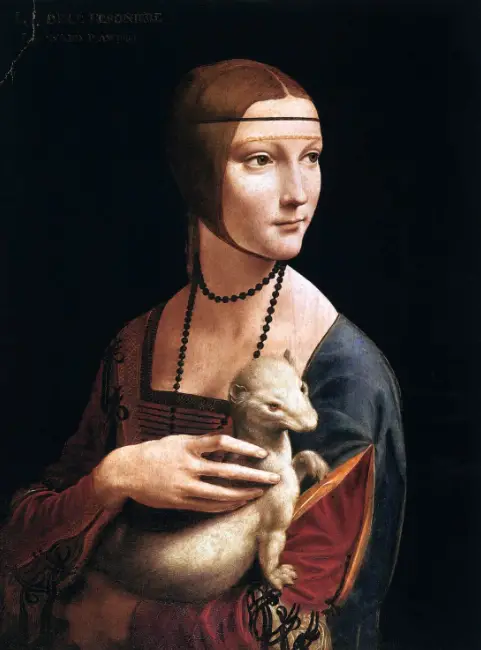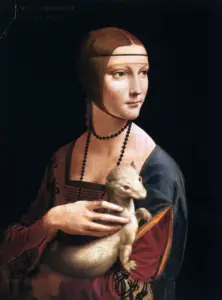Leonardo da Vinci Lady with an Ermine
Title: Lady with an Ermine (Portrait of Cecilia Gallerani)
Year: 1489-1491
Size: 54 x 39 cm
Medium: Oil on wood
Location: Czartoryski Museum, Cracow, Poland
The Lady with an Ermine painting is a portrait painting generally ascribed to Leonardo da Vinci, an Italian Renaissance artist. Da Vinci Lady with an Ermine, which dates from 1489 to 1491, is painted in oils on a walnut wood panel. It represents a half-height woman rotated three-quarters to the right, but with her face turned to the left. The animal in her arms twists similarly, resulting in significant contrapposto with the lady, a technique Leonardo had previously explored with the angel in the Virgin of the Rocks.
What is the meaning of Lady with an Ermine?
A layer of white gesso and a layer of brownish underpaint are used to prepare the painting. The paint is applied evenly in general, similar to the Mona Lisa, while particular portions of the lady’s skin are more layered. Its subject is Cecilia Gallerani, an enticing young woman from the Milanese court who was the favorite mistress of Ludovico Sforza, Duke of Milan at the time of its execution; Leonardo was a painter to the Sforza court in Milan at the time of its execution.
For 18 years, the duke was da Vinci’s patron and champion, earning him the moniker “the white ermine.” It is the second of Leonardo’s only four surviving portraits of women, the others being La Belle Ferronnière, Ginevra de’ Benci, and the Mona Lisa.
What is an Ermine?
The Lady with an Ermine painting was purchased by the youthful Prince Adam Czartoryski (a hero in the war for Polish independence) on his trip to Italy in 1800. Leonardo da Vinci Lady with an Ermine was commissioned by his mother, an avid collector and the founder of the Czartoryski Museum.
Art experts first assumed that the animal in the picture was merely a decorative element. They later discovered that ermine is an allusion to Lodovico Sforza. Why is this so? He was also known as Ermellino Bianco at times (white ermine). Leonardo was unable to paint a couple together due to the upcoming wedding of Ludovico and Beatrice d’Este. That is why he was portrayed allegorically as an ermine, which also covers Cecilia’s pregnancy, Cesare, his son, was born soon after.
The image vanished for generations after Cecilia’s death until resurfacing in Poland around 1800. For many years, it was mistakenly thought to be the likeness of the so-called “Belle Ferronière,” a rumored mistress of King Francis I. The inscription LA BELE FERONIERE / LEONARD D’AWINCI in the upper left corner alongside the artist’s surname, which is spelled in Polish, attests to this. However, given Polish history in the twentieth century, it is remarkable that the Lady with an Ermine painting has survived.
What is the price of Lady with an Ermine?
There is substantial debate over whether the Lady with an Ermine picture was created by da Vinci, Boltraffio, or da Predis. During one of his visits, Prince Adam Czartoryski purchased the picture of Lady with an Ermine in Italy. In 1800, he added the artwork to the Czartoryski Family collection. The picture is now housed in the Czartoryski Museum in Krakow, Poland, but it is currently traveling to museums across the world because the Czartoryski Museum is undergoing renovations, which began in 2010.
On December 29, 2016, the Princes Czartoryski Foundation, represented by Adam Karol Czartoryski, the last direct offspring of Izabela Czartoryska Flemming and Adam George Czartoryski, who brought the painting to Poland from Italy in 1798, sold it to the Polish government for a sum of €100 million.


 I’m Leonardo Bianchi, the mind behind Leonardo da Vinci's Inventions. Thanks for visiting.
I’m Leonardo Bianchi, the mind behind Leonardo da Vinci's Inventions. Thanks for visiting. 


